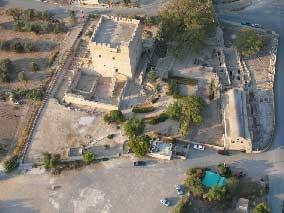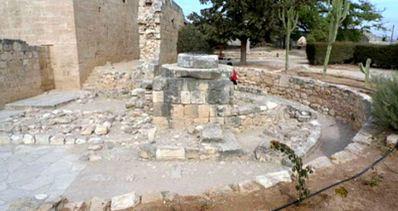Excavations at the Kolossi Sugar Mill
Department of Antiquities
Source - http://your-story.org/cyprus-archaeological-excavations-at-the-kolossi-sugar-mill-298343/
The Ministry of Communications and Works, Department of Antiquities, announces the completion of the eighteenth excavation season at the Medieval Sugar Mill of Kolossi, in Limassol District.
The excavations, which lasted for four weeks, from 31st of October until 25th of November 2011, were under the direction of the Curator of Antiquities, Dr. Marina Solomidou-Ieronymidou, helped by archaeologist Mrs Doria Nicolaou, Technician A’ Mrs M. Makri-Chamberlain and a team of six workers.

The main goal of this year’s excavation campaign was the continuation of the investigation in the south and southeast of the excavated area of the sugar mill’s installations. Also the excavation of the rectangular cistern which came to light during last year’s excavation season was concluded.
The stratigraphy of the cistern’s fill shows the sequence of two different layers, a fact that could prove that after the abandonment phase the fill of earth has been realized at once and not gradually. Its maximum depth is 2.25 m. This cistern, unlike the other one which was found further to the east, preserves some interesting cuttings at the bottom related to its use.
The cavities present on the two lateral sides of both cisterns are hewn quite in the middle of each side. A piece of metal, 0,30 m. long, was found embedded in the northern cavity and it is probably related to a mechanism that served its use.
The movable finds in the respective layers consist of a great number of broken sugar vessels, mostly of the conical type. One sherd (rim) bears an interesting rough incision of the representation of a schematic tree.
The only table ware found in the fill was a fragment of a dark green glazed ware. The movable finds consisted apart from the ceramics, some iron nails. The skeletal remains of a small animal were also unearthed in the same layer.
The archaeological investigation continued to the west of the above mentioned cistern where two perpendicular walls were already visible in the southwest corner of the section before the excavation.
These are very rough constructions, built on a higher level than that of the sugar mill’s installations and constitute later interventions.
To the north of the wall, a crude pavement of white mortar was traced, which consists the most recent evidence of human activity before the fill, dating back to the colonial period.
The archaeological layer beneath this floor brought to light some interesting features which could be related to a metallurgical workshop, taking into account the huge amount of slag found in the corresponding layer. A rectangular feature came to light, constituted by one course of stones.
Worked stones were used in its borders, since the interior was filled with smaller, not worked stones. No plaster was used for its construction. It measures 1,35 m. x 1,24 m. and its height is between 0.20 m. – 0.30 m.

Above this feature, a red, very hard, compact layer of approximately 0,50 m. thick, a result of mud-bricks’ overlay, was excavated. A great quantity of ash and slag to the west of the feature suggests the existence of a hearth, roughly delimited by stones and bricks.
Burning traces (charcoal and ashes) as well as slag residues were excavated all around the rectangular feature. The floor, on which the feature is constructed, is constituted by burnt bricks, some stones, grey mortar and the bedrock at the northwest part of the section.
In the corresponding layer of the section which extends to the north, excavated during last year’s season, a similar layer came to light. The only chronological indication provided in this area were the fragments of a majolica plate. The research will continue next year in order to clarify the older layers related to the sugar mill’s activities.
This year’s excavation extended also to the west of the vaulted building of the refinery. A pavement, made of slabs and pebbles, preserved in a very good condition, was brought to light. A wall which runs parallel to the west of the western wall of the refinery determines the pavement’s eastern limits. This pavement seems to extend to the south and west, where the excavation will continue next year.